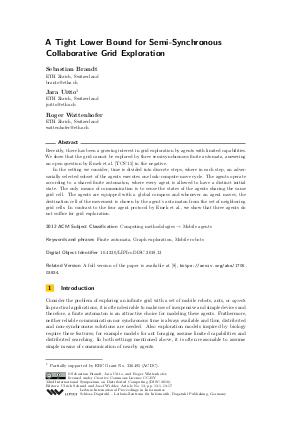A Tight Lower Bound for Semi-Synchronous Collaborative Grid Exploration
Authors Sebastian Brandt, Jara Uitto, Roger Wattenhofer
-
Part of:
Volume:
32nd International Symposium on Distributed Computing (DISC 2018)
Part of: Series: Leibniz International Proceedings in Informatics (LIPIcs)
Part of: Conference: International Symposium on Distributed Computing (DISC) - License:
 Creative Commons Attribution 3.0 Unported license
Creative Commons Attribution 3.0 Unported license
- Publication Date: 2018-10-04
File

PDF
LIPIcs.DISC.2018.13.pdf
- Filesize: 487 kB
- 17 pages
Document Identifiers
Related Versions
Subject Classification
ACM Subject Classification
- Computing methodologies → Mobile agents
Keywords
- Finite automata
- Graph exploration
- Mobile robots
Metrics
- Access Statistics
-
Total Accesses (updated on a weekly basis)
0PDF Downloads0Metadata Views
Abstract
Recently, there has been a growing interest in grid exploration by agents with limited capabilities. We show that the grid cannot be explored by three semi-synchronous finite automata, answering an open question by Emek et al. [TCS'15] in the negative. In the setting we consider, time is divided into discrete steps, where in each step, an adversarially selected subset of the agents executes one look-compute-move cycle. The agents operate according to a shared finite automaton, where every agent is allowed to have a distinct initial state. The only means of communication is to sense the states of the agents sharing the same grid cell. The agents are equipped with a global compass and whenever an agent moves, the destination cell of the movement is chosen by the agent's automaton from the set of neighboring grid cells. In contrast to the four agent protocol by Emek et al., we show that three agents do not suffice for grid exploration.
Cite As Get BibTex
Sebastian Brandt, Jara Uitto, and Roger Wattenhofer. A Tight Lower Bound for Semi-Synchronous Collaborative Grid Exploration. In 32nd International Symposium on Distributed Computing (DISC 2018). Leibniz International Proceedings in Informatics (LIPIcs), Volume 121, pp. 13:1-13:17, Schloss Dagstuhl – Leibniz-Zentrum für Informatik (2018)
https://doi.org/10.4230/LIPIcs.DISC.2018.13
BibTex
@InProceedings{brandt_et_al:LIPIcs.DISC.2018.13,
author = {Brandt, Sebastian and Uitto, Jara and Wattenhofer, Roger},
title = {{A Tight Lower Bound for Semi-Synchronous Collaborative Grid Exploration}},
booktitle = {32nd International Symposium on Distributed Computing (DISC 2018)},
pages = {13:1--13:17},
series = {Leibniz International Proceedings in Informatics (LIPIcs)},
ISBN = {978-3-95977-092-7},
ISSN = {1868-8969},
year = {2018},
volume = {121},
editor = {Schmid, Ulrich and Widder, Josef},
publisher = {Schloss Dagstuhl -- Leibniz-Zentrum f{\"u}r Informatik},
address = {Dagstuhl, Germany},
URL = {https://drops.dagstuhl.de/entities/document/10.4230/LIPIcs.DISC.2018.13},
URN = {urn:nbn:de:0030-drops-98029},
doi = {10.4230/LIPIcs.DISC.2018.13},
annote = {Keywords: Finite automata, Graph exploration, Mobile robots}
}
Author Details
Funding
- Uitto, Jara: Partially supported by ERC Grant No. 336495 (ACDC).
References
-
Susanne Albers and Monika Henzinger. Exploring Unknown Environments. SIAM Journal on Computing, 29:1164-1188, 2000.

-
Romas Aleliunas, Richard M. Karp, Richard J. Lipton, Laszlo Lovasz, and Charles Rackoff. Random Walks, Universal Traversal Sequences, and the Complexity of Maze Problems. In FOCS, pages 218-223, 1979.

-
Igor Averbakh and Oded Berman. A Heuristic with Worst-case Analysis for Minimax Routing of Two Travelling Salesmen on a Tree. Discrete Appl. Math., 68(1-2):17-32, 1996.

-
Ricardo A. Baeza-Yates, Joseph C. Culberson, and Gregory J. E. Rawlins. Searching in the Plane. Information and Computation, 106:234-252, 1993.

-
M. A. Bender and D. K. Slonim. The Power of Team Exploration: Two Robots can Learn Unlabeled Directed Graphs. In FOCS, pages 75-85, 1994.

-
M. Blum and W. J. Sakoda. On the capability of finite automata in 2 and 3 dimensional space. In FOCS, pages 147-161, 1977.

-
Manuel Blum and Dexter Kozen. On the Power of the Compass (or, Why Mazes Are Easier to Search Than Graphs). In FOCS, pages 132-142, 1978.

- Sebastian Brandt, Jara Uitto, and Roger Wattenhofer. Tight Bounds for Asynchronous Collaborative Grid Exploration. CoRR, abs/1705.03834, 2017. URL: http://arxiv.org/abs/1705.03834.
-
Lothar Budach. Automata and Labyrinths. Mathematische Nachrichten, 86(1):195-282, 1978.

- Marek Chrobak, Leszek Gasieniec, Thomas Gorry, and Russell Martin. Group Search on the Line, pages 164-176. Springer Berlin Heidelberg, 2015. URL: http://dx.doi.org/10.1007/978-3-662-46078-8_14.
-
Lihi Cohen, Yuval Emek, Oren Louidor, and Jara Uitto. Exploring an Infinite Space with Finite Memory Scouts. In SODA, pages 207-224, 2017.

-
Xiaotie Deng and Christos Papadimitriou. Exploring an Unknown Graph. Journal of Graph Theory, 32:265-297, 1999.

-
Krzysztof Diks, Pierre Fraigniaud, Evangelos Kranakis, and Andrzej Pelc. Tree Exploration with Little Memory. Journal of Algorithms, 51:38-63, 2004.

-
Yann Disser, Jan Hackfeld, and Max Klimm. Undirected Graph Exploration with Θ(log log n) Pebbles. In SODA, pages 25-39, 2016.

-
Christian A. Duncan, Stephen G. Kobourov, and V. S. Anil Kumar. Optimal Constrained Graph Exploration. ACM Trans. Algorithms, 2(3):380-402, 2006.

- Yuval Emek, Tobias Langner, David Stolz, Jara Uitto, and Roger Wattenhofer. How Many Ants Does it Take to Find the Food? Theor. Comput. Sci., 608:255-267, 2015. URL: http://dx.doi.org/10.1016/j.tcs.2015.05.054.
-
Yuval Emek, Tobias Langner, Jara Uitto, and Roger Wattenhofer. Solving the ANTS Problem with Asynchronous Finite State Machines. In ICALP, pages 471-482, 2014.

-
Ofer Feinerman, Amos Korman, Zvi Lotker, and Jean-Sebastien Sereni. Collaborative Search on the Plane Without Communication. In PODC, pages 77-86, 2012.

-
P. Flocchini, G. Prencipe, N. Santoro, and P. Widmayer. Distributed Coordination of a Set of Autonomous Mobile Robots. In Intelligent Vehicles Symposium, pages 480-485, 2000.

- Pierre Fraigniaud and David Ilcinkas. Digraphs Exploration with Little Memory, pages 246-257. Springer Berlin Heidelberg, 2004. URL: http://dx.doi.org/10.1007/978-3-540-24749-4_22.
-
Frank Hoffmann. One Pebble Does Not Suffice to Search Plane Labyrinths. In FCT, pages 433-444, 1981.

-
Alejandro López-Ortiz and Graeme Sweet. Parallel Searching on a Lattice. In CCCG, pages 125-128, 2001.

-
Petrişor Panaite and Andrzej Pelc. Exploring Unknown Undirected Graphs. In SODA, pages 316-322, 1998.

- H. A. Rollik. Automaten in Planaren Graphen, pages 266-275. Springer Berlin Heidelberg, Berlin, Heidelberg, 1979. URL: http://dx.doi.org/10.1007/3-540-09118-1_28.
-
Kazuo Sugihara and Ichiro Suzuki. Distributed Algorithms for Formation of Geometric Patterns with Many Mobile Robots. Journal of Robotic Systems, 13(3):127-139, 1996.

-
Ichiro Suzuki and Masafumi Yamashita. Distributed Anonymous Mobile Robots: Formation of Geometric Patterns. SIAM Journal on Computing, 28(4):1347-1363, 1999.

-
Ichiro Suzuki and Masafurni Yarnashita. Distributed Anonymous Mobile Robots - Formation and Agreement Problems. In SIROCCO, pages 1347-1363, 1996.

